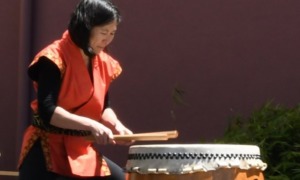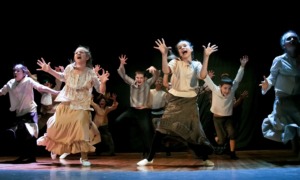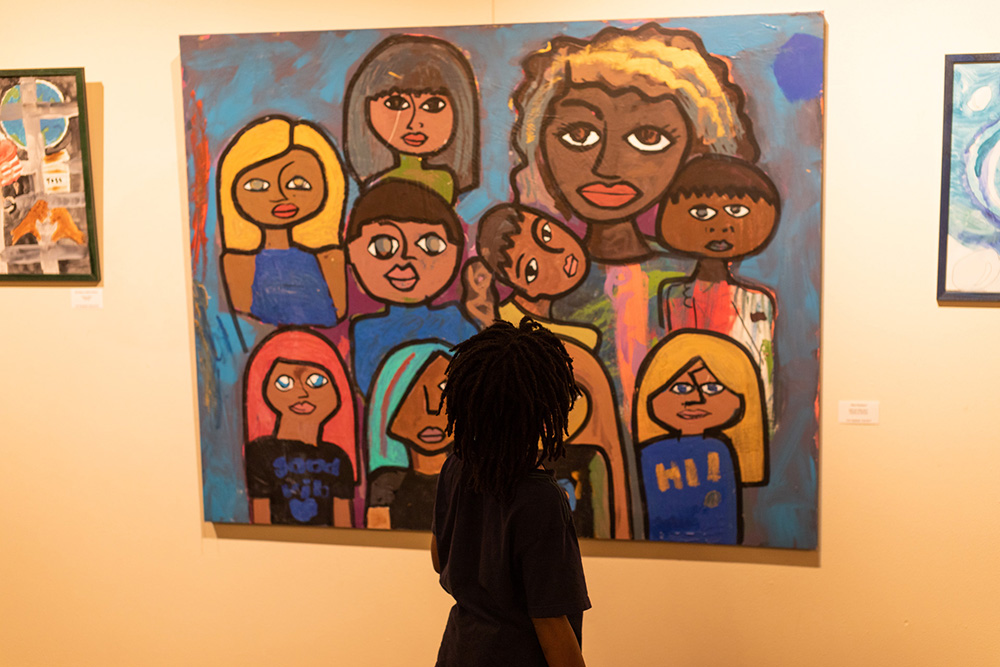
Photos by Boys & Girls Clubs of Central Minnesota
Professional teaching artists use youth development principles to bring sophisticated arts training to Boys & Girls Clubs in three cities. Here, the Boys & Girls Clubs of Central Minnesota holds an art showcase.
A pilot program bringing sophisticated arts programming to kids in high-poverty communities engaged young teenagers and, as a result, has energized youth organizations to ramp up their efforts.
The project will now widen with additional funding from the Wallace Foundation.
The Boys & Girls Clubs Youth Arts Initiative brought professional teaching artists to clubs in three Wisconsin and Minnesota cities from 2014 to 2018.
“Kids who participated in the Youth Arts Initiative program connected with the club longer and participated more often,” said Aimee Minnerath, Youth Arts Initiative director, Boys & Girls Clubs of Central Minnesota in St. Cloud. A report by Research for Action evaluated the impact from 2014-16.
The Youth Arts Initiative explored a way to bring high-quality arts to kids who otherwise might lack such opportunities.
It was aimed at middle-schoolers, the age when participation in after-school programs drops off. It’s also the age when youth are making decisions about the interests they will pursue and directions they will go, said Stephanie Nespoli, director of communications and development at the Boys & Girls Club of Green Bay (Wis.).
Not only did the project engage a hard-to-reach age group, it propelled the participating clubs beyond arts and crafts and helped them develop best practices for skilled instruction. It also showed that large, national youth-serving organizations with a broad focus can offer such instruction.
Scaling up
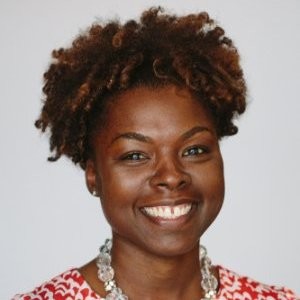
Bahia Ramos
This month the program is starting in Boys & Girls Clubs in five new cities: Atlanta; Austin, Texas; Knoxville, Tenn.; New York, and Orlando, Fla.
The clubs are working on plans and beginning to hire teaching artists, said Bahia Ramos, director of arts for the Wallace Foundation. They’ll launch the full program in September, she said. A three-year $13 million grant from the foundation will support their efforts.
The three clubs in the pilot program — in St. Cloud, Green Bay and Milwaukee — will be continuing their work.
La’Ketta Caldwell, arts director for the Boys & Girls Clubs of Greater Milwaukee, said the organization has reached out to local funders to support the program now that the pilot grant is over.
Among teaching artists at the Milwaukee club is dancer Cedric Gardner. He leads a dance troupe at the organization’s Davis clubhouse and took them to a Los Angeles competition last year. He has appeared on the TV show “So You Think You Can Dance” and worked on choreography for the Fox series “Empire.”
Mural artist Vedale Hill teaches visual art for the Milwaukee club. His students visited artistic landmarks in New York, Chicago and Milwaukee. In August they unveiled their own installation honoring civil rights pioneer Ruby Bridges.
The St. Cloud club will be expanding its program and has raised more than $107,000.
The organization serves 2,800 kids at three clubhouses, as well as another 3,700 at 15 school sites.
“Our Boys & Girls Club has been committed to the arts,” but prior to the Youth Arts Initiative the arts were presented more as a hobby, Minnerath said.
Foundation funding allowed the club to hire two full-time and two part-time teaching artists. About 650 kids took part in dance, visual arts, digital media and fashion design.
Kids become committed “because they have something meaningful and connecting to do,” she said. “And the arts connects kids who are not feeling connected in other areas.”
In addition to skill in the art, they develop “tangible 21st-century skills,” she said, such as the ability to work as a team and speak in front of groups.
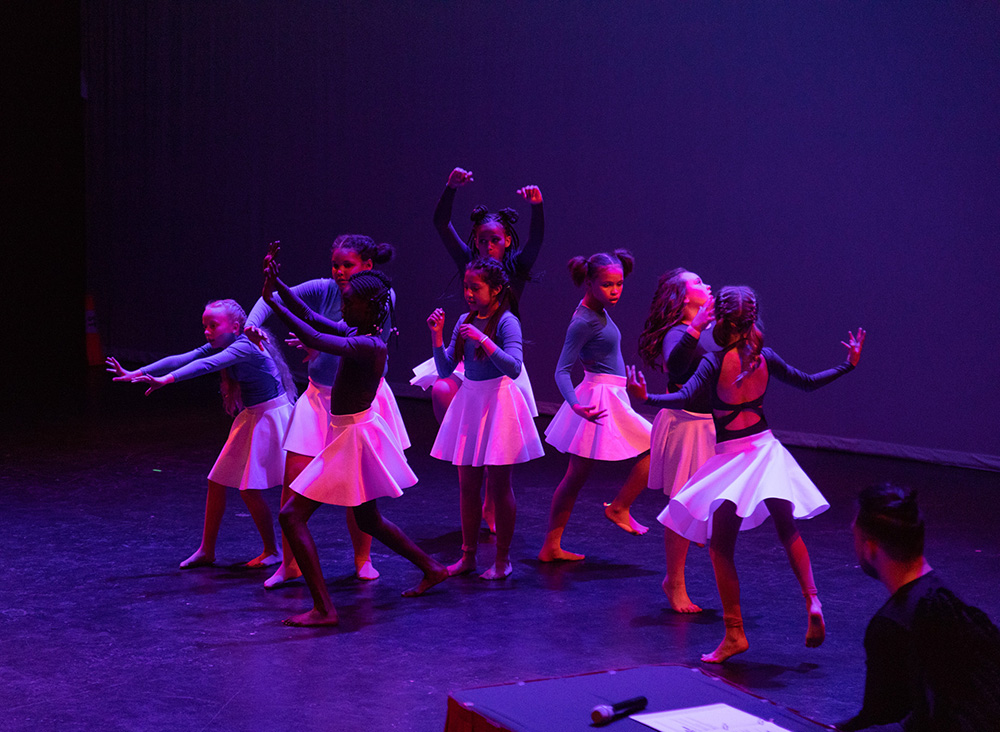
A culture of high expectations is part of Youth Arts Initiative training. Here, dancers perform at the Boys & Girls Clubs of Central Minnesota.
Practices that work
The Youth Arts Initiative developed a set of practices described by the Wallace Foundation in an earlier report.
Kids are taught by professional artists, Minnerath said, and every program has a public, culminating event. It’s also important for students to have meaningful leadership opportunities and to have classes held in inspiring dedicated spaces, she said.
Other principles include:
- A culture of high expectations.
- Executive directors with a public commitment to high-quality arts education.
- Positive relationships with adult mentors and peers.
- Engagement of key stakeholders, creating community support.
- Hands-on skill-building.
- Physical and emotional safety.
2nd wave to consider cost, efficiency
The pilot program showed that if clubs follow these principles youth will be interested and the program will attract attention and make the arts more visible, said Ramos of the Wallace Foundation.
She said the second wave of the project will try to find ways to lower the cost so the program can be adopted by more organizations and benefit more children.
Efforts to achieve greater cost efficiency might include a “hub-and-spoke model” in which instruction is provided at one clubhouse but shared by surrounding sites, Ramos said.
Kids might rotate between sites to get different arts instruction, and clubs might also partner with arts organizations based in their city, she said.
Clubs will have more flexibility in program offerings than they had in the pilot project. They will look at extending the instruction to high school age students so kids can continue to pursue their artistic interests as they get older, she said.
“The objective for Wallace is to have more kids have access to the arts,” Ramos said.
Over the first three years, the Boys & Girls Clubs in Minnesota and Wisconsin learned some things about effectively setting up a program.
“Make sure you have buy-in from club management and staff,” said Minnerath of the Boys & Girls Club in St. Cloud. “Don’t do it in a vacuum.”
Executive leadership must have passion and dedication for the arts and a desire to bring the arts to everyone, she said.


